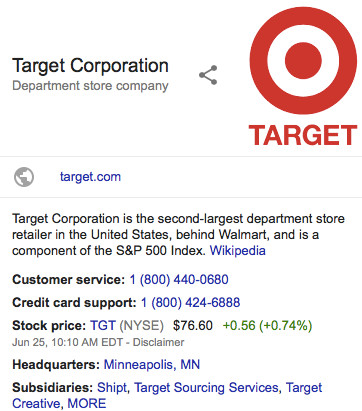Is Google´s best kept secret hiding in plain sight?
70% of direct searches never click to a website
One of the highlights at StreetFight´s June conference was GetFiveStars' co-founder Mike Blumenthal´s study of an emerging feature of Google that has been overlooked by most business and media companies.
GetFiveStars provides review monitoring and response, and along the way Blumenthal noticed the increasing importance of the Google panel that shows up on the right of Google my business results.
Specifically, that Google seems to be turning the panel into a kind of alternative website. The new FAQ section is created by crowd-sourced Q&As that have no monitoring by API, have suddenly scaled. So his company now offers monitoring as a service.
Just as important is the Google panel to an SMB. Blumenthal contends it is used by 70% of customers directly, rather than going to the website (25%) or from Facebook (4%).
The Q&A section is little known as yet by most businesses and media companies, but it serves as the virtual FAQ section.
"It is the first time we have seen this at such scale on virutally every business," said Blumenthal, "it can be a dream come true or potential nightmare.”
That´s because, like Facebook or Yelp, Google is excluded by Section 230 of Communications Decency Act, from being sued when people use their platform for defamation. By federal law, they have no obligation to take it down, and while they will, sometimes, Blumenthal says the process is slow. Ten days to two weeks, for whatever their filters don´t catch, too late if a question or answer goes viral.
At the StreetFight Summit, Blumenthal asked the audience to visit one company's panel whose Q&A begins, "Does anyone else but me think this store is racist..." and goes on. The response starts out, "I´m not surprised..."
"Here we are having the most difficult conversation in our country" in a Google Q&A section that most companies are not aware of, Blumenthal said.
Curious, Blumenthal asked his developers to build a tool that can scrape the Q&A sections from 1,800 businessses. Then he looked at the data.
A total of 450 questions per month were asked and answered, “largely unseen by brands, with no tools to monitor them.” Locations with questions ranged from 15% for home services to 98% for big box retailers (Target, Walmart, etc.), with an average of 20 per location, from “Can I park in your parking lot” to “Why don´t they answer their phones.”
There was one suicide threat.
About 9% of users violate Google policies with irrelevant or commentary-style questions, such as "Why are there still drug addicts and atheists still working in the building and why is Sandra still covering for them?” or “Why is Walmart so full of bums.”
An analysis of Q&As for the dentist sites, for example, contained only 38% legitimate FAQ questions (32% on services and 7% on business basics). 6% of questions were irrelvant. 6% requested an appointment and 11% were reputation oriented.
Blumenthal´s suggestion for SMBs is sensible: Post, monitor, respond, report abuse.
Posting means creating real FAQ questions and answers in the customers voice, though revealing that the company itself is the source for the answers.
“Monitoring is something every brand should be doing,” he said, as well as responding and reporting abuse.
He likens the Q&A section to a “canary in the coal mine. it...can be used and should be used as such.”






